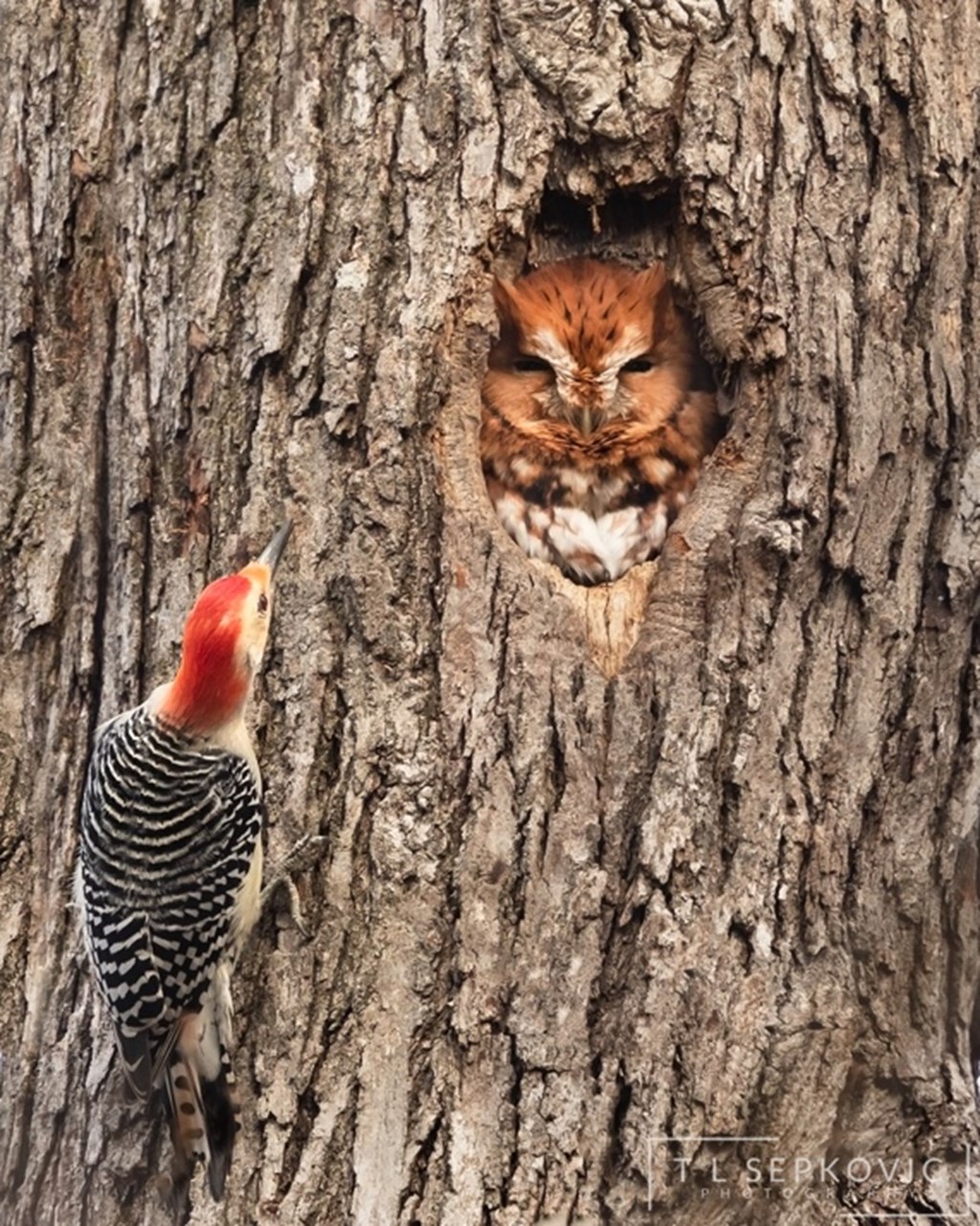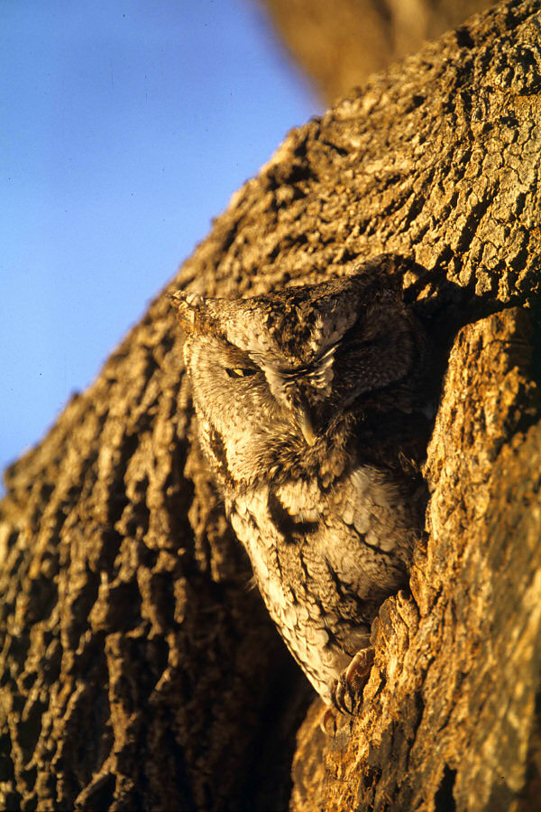Eastern Screech Owl
Megascops asio

Name
The genus name for this species comes from the Greek words mega meaning “great or large” and skо̄ps meaning “an owl.” The species asio comes from Latin for “a horned owl.” The common name “screech” refers to the wide array of sounds this owl makes at night, which are rarely screeches. Folk names such as “whickering” or “whinnerying” owl more appropriately describe this raptor’s vocalizations. Other common names include cat owl, little gray owl, spirit owl, and dusk owl.
General Description
Eastern screech owls are small, compact, nocturnal owls with ear tufts and lemon-yellow eyes. There are 2 common color morphs; gray and rufous, or “red.” Gray morphs are the predominate morph in Pennsylvania and are more cold-hearty than their southern, reddish cousins. Red and gray morphs will mate together, producing brownish-gray offspring. Screech owls camouflage effectively against tree bark and are readily found in suburban areas throughout the Eastern United States. There is a slight difference in size, with females being the larger of the two sexes, a pattern called “reversed sexual dimorphism.”
Similar Species: In the Eastern United States there is no range overlap between the Eastern screech owls two closest look-alikes; the Western screech owl and whiskered screech owl.
Fun Facts
• The Eastern screech owl has the broadest “ecological niche,” of any Eastern owl, meaning they can excel in the widest variety of environments.
• They are the most common feathered predator in urban areas.
• According to a long-term study conducted by screech owl researcher Fred Gelhbach, shifting global climate has resulted in an earlier nesting start date for Eastern screech owls in Texas by 4.5 days.
• Screech owls will sometimes elongate their bodies to blend in with a tree branch and even sway to mimic the movement of a tree, called the “broken stick” tactic.
• The reason behind the different color morphs of the Eastern screech owl is unknown. However, red morphs seem to be more prevalent in warm, humid regions.
• The average lifespan of a screech owl in the wild is 3 to 7 years.
• Screech owls are preyed upon by great-horned owls, barred owls, great gray owls, short-eared owls, snowy owls, hawks, and crows.
• While screech owls are vulnerable to West Nile virus, surviving females can pass on immunity to their chicks.
• Eastern screech owls are larger the further north they live.
Size
| Females | Males | |
| Wingspan | 56 cm (22 in.) ✏️✏️✏️ 3 pencils end-to-end | About the same |
| Mass | 165-175 g (6 oz) 🍋🍋 1 ½ lemons | 160-165 g (5 oz) 🍋 1 lemon |

Vocals
Eastern screech owls exhibit several different vocalizations. Their “whinny” call is descending in pitch and often given in territorial defense. Henry David Thoreau referred to this call as “a most solemn graveyard ditty, the mutual consolations of suicide lovers.”
Their monotone trill is used between family members, and mated pairs will sometimes trill in unison. Screech owls will also bark, hoot, squeal, and screech. Vocalizations typically occur throughout the breeding season starting with courtship and establishment of territories all the way through fledgling time. Males have a lower pitch than females.
Habitat
Eastern screech owls thrive best in patches of mixed forest landscapes, similar to what is found in most of suburban Eastern North America. They avoid continuous tracts of forest, and areas of high elevation. Factors that likely dictate the presence of screech owls include a low density of predators, a nearby waterway, ample nest cavities, evergreens for roosting, and optimal hunting grounds. Suburbia often provides these requirements. Home range size varies with season; their range during nesting season can be up to 100 hectares (250 acres) and shrink to 9 hectares (22 acres) during the winter.
Feeding
Eastern screech owls have varied diets. Documented prey items include mice, voles, insects, crayfish, earthworms, spiders, amphibians, reptiles, small fish, small birds, snails, the occasional bat, and even other screech owls! Screech owls are opportunistic feeders and take advantage of seasonal abundance in prey. For example, they may switch between consuming fish or insects during the summer, to primarily vertebrates during the winter. These habits vary with latitude; screech owls further North have a limited variety of available prey compared to their southern counterparts.
Feeding behavior consists of watching, waiting, and snatching prey. Occasionally screech owls will hover before seizing their meal. They hunt mostly at night, but like other owls, are active at dusk and dawn. Individual screech owls expel roughly two pellets per day, containing bones fragments and other indigestible parts of their prey.

Nesting
During screech owl courtship, the male approaches the female by emitting vocalizations as he nears her location. He then bobs his head and body, in hopes that she will accept his advance. If the female is interested, she will move closer and closer to him until their beaks touch and they begin to preen each other.
Eastern screech owls have a relatively short breeding season, lasting between March and June, though pairs may begin prospecting for a nest site as early as February. Pairs use secondary cavities, meaning they do not create the holes themselves but take advantage of rotting trees, woodpecker holes, and other natural openings. Screech owls maintain caching and roosting cavities in addition to their nesting cavity whenever possible.
Females lay 3 to 5 eggs and incubate for 30 days. She remains the primary caregiver in the nest until chicks are able to thermoregulate on their own. The male provides meals to the family during this time. Parents withhold food at the appropriate fledging time to coax the nestlings into their first flight, after which they continue to provide food for 8 to 10 weeks. Entire families of screech owls have been seen roosting together in one tree after the fledglings have left the nest.
Roughly 80% of screech owls attempt to breed in their first year of life. As a short-lived species, individual birds understandably hope to contribute to the gene pool as early as possible. There is also a high mortality rate among screech owls, creating in turn high individual turnover and therefore potential incentive for individuals to breed early. Screech owls demonstrate high site fidelity, meaning they return to the same successful nest sites as long as they remain available.
Migration
Eastern screech owls are non-migratory throughout their range, though like other residential raptors, they may travel during times of scarce resources. Young birds are likely to disperse and wander in search of adequate territories, preparing for when they are ready to breed. Screech owl territories may be as close as 45 meters (49 yards) to another nesting pair, and the average juvenile disperses 2.5 to 4 kilometers (1 to 1.7 miles) from their birthplace.

Current Conservation Status
Eastern screech owls are listed as a Species of Least Concern under the IUCN’s Red List. Screech owls are declining, yet their population is large enough that they are not yet considered a global conservation priority. To view a detailed explanation of this listing, visit www.iucnredlist.org.
However, Hawk Mountain founder Rosalie Edge emphasized the need to protect a species while it is still common. Screech owls are compatible with suburban environments. However, they still require essential habitat features such as nest cavities, safety from predators, a reduction in vehicle collisions (a leading cause in screech owl mortality) and appreciation from humans. You can support your local screech owl population by driving slowly at night, refraining from rodenticide use, leaving trees with cavities standing when possible, installing screech owl nest boxes, and acknowledging the role these owls play in your neighborhood rodent and insect populations. Most importantly, you can spread the word about how amazing these charismatic screech owls truly are, and support Hawk Mountain in our work to help support owl populations worldwide.
Special thanks to George Aldredge, Traci Sepkovic, and Chris Brinkman, for their generous photo contributions to this account.
Information written and compiled by Zoey Greenberg.
Sources
Beauty of Birds. (2011). Screech Owls: Interesting Facts. Retrieved from: https://www.beautyofbirds.com/screechowltidbits.html
Cornell Lab of Ornithology. (2019). All About Birds: Eastern Screech Owl. Retrieved from https://www.allaboutbirds.org/guide/Eastern_Screech-Owl/
Weidensaul, Scott. (2015). Owls of North America and the Caribbean. New York: NY.: Peterson Field Guides.
Johnsgard, P. A. (1988). North American owls: biology and natural history. Washington, D.C.: Smithsonian Institution Press.